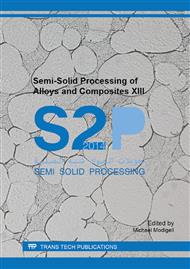p.325
p.332
p.340
p.347
p.355
p.361
p.366
p.374
p.381
Semi-Solid Joining of D2 Cold-Work Tool Steel
Abstract:
Cold-work tool steel is considered to be a non-weldable metal due to its high percentage content of carbon and alloying elements. To address this problem the application of a new process of semisolid joining using a direct partial remelting method was developedto achieve a spherical join structure between two parts of AISI D2 cold-work tool steel. Since the surface oxidation of this metalis very high, the control of the atmosphere during joining had to be considered. Samples were heated in an argon atmosphere at two different temperatures of 1250°C and 1275°C for 10 minutes. Metallographic analyses along the joint interface showed that an increase in temperature promoted the final joining properties and also that at a liquid fraction of 15% joining was not fully practicable. However, a20% liquid fraction can produce a very good joint and microstructure as compared to the other experimental liquid fraction. Metallographic analyses along the joint interface showed a smooth transition from one to the other and neither oxides nor microcracking was observed. The current work confirmed that avoidance of a dendritic microstructure in the semisolid joined zone and high bonding quality components can be achieved without the need for force or complex equipment when compared to conventional welding processes.
Info:
Periodical:
Pages:
355-360
Citation:
Online since:
September 2014
Price:
Сopyright:
© 2015 Trans Tech Publications Ltd. All Rights Reserved
Share:
Citation:


